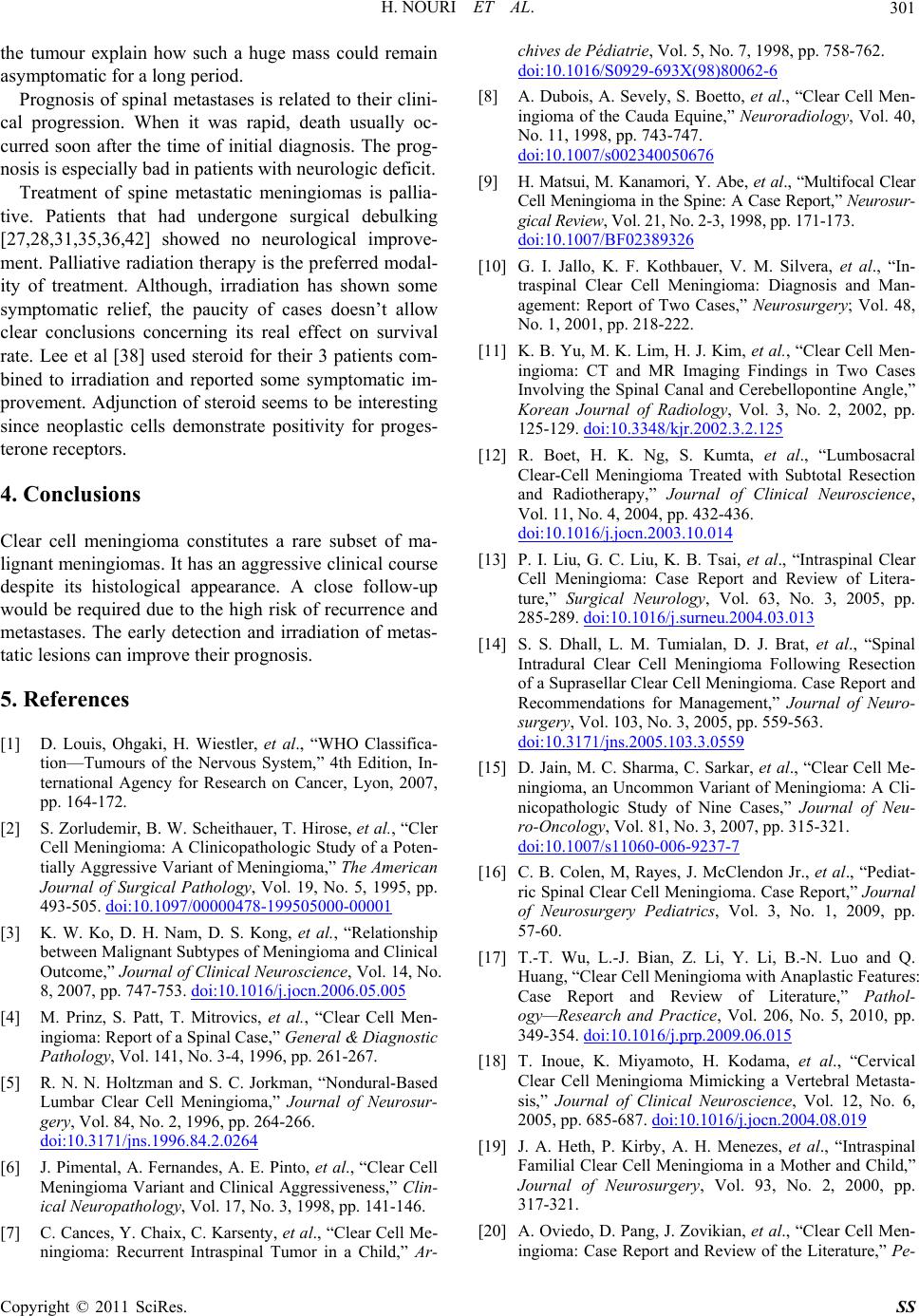
H. NOURI ET AL.
Copyright © 2011 SciRes. SS
301
the tumour explain how such a huge mass could remain
asymptomatic for a long period.
Prognosis of spinal metastases is related to their clini-
cal progression. When it was rapid, death usually oc-
curred soon after the time of initial diagnosis. The prog-
nosis is especially bad in patients with neurologic deficit.
Treatment of spine metastatic meningiomas is pallia-
tive. Patients that had undergone surgical debulking
[27,28,31,35,36,42] showed no neurological improve-
ment. Palliative radiation therapy is the preferred modal-
ity of treatment. Although, irradiation has shown some
symptomatic relief, the paucity of cases doesn’t allow
clear conclusions concerning its real effect on survival
rate. Lee et al [38] used steroid for their 3 patients com-
bined to irradiation and reported some symptomatic im-
provement. Adjunction of steroid seems to be interesting
since neoplastic cells demonstrate positivity for proges-
terone receptors.
4. Conclusions
Clear cell meningioma constitutes a rare subset of ma-
lignant meningiomas. It has an aggressive clinical course
despite its histological appearance. A close follow-up
would be required due to the high risk of recurrence and
metastases. The early detection and irradiation of metas-
tatic lesions can improve their prognosis.
5. References
[1] D. Louis, Ohgaki, H. Wiestler, et al., “WHO Classifica-
tion—Tumours of the Nervous System,” 4th Edition, In-
ternational Agency for Research on Cancer, Lyon, 2007,
pp. 164-172.
[2] S. Zorludemir, B. W. Scheithauer, T. Hirose, et al., “Cler
Cell Meningioma: A Clinicopathologic Study of a Poten-
tially Aggressive Variant of Meningioma,” The American
Journal of Surgical Pathology, Vol. 19, No. 5, 1995, pp.
493-505. doi:10.1097/00000478-199505000-00001
[3] K. W. Ko, D. H. Nam, D. S. Kong, et al., “Relationship
between Malignant Subtypes of Meningioma and Clinical
Outcome,” Journal of Clinical Neuroscience, Vol. 14, No.
8, 2007, pp. 747-753. doi:10.1016/j.jocn.2006.05.005
[4] M. Prinz, S. Patt, T. Mitrovics, et al., “Clear Cell Men-
ingioma: Report of a Spinal Case,” General & Diagnostic
Pathology, Vol. 141, No. 3-4, 1996, pp. 261-267.
[5] R. N. N. Holtzman and S. C. Jorkman, “Nondural-Based
Lumbar Clear Cell Meningioma,” Journal of Neurosur-
gery, Vol. 84, No. 2, 1996, pp. 264-266.
doi:10.3171/jns.1996.84.2.0264
[6] J. Pimental, A. Fernandes, A. E. Pinto, et al., “Clear Cell
Meningioma Variant and Clinical Aggressiveness,” Clin-
ical Neuropathology, Vol. 17, No. 3, 1998, pp. 141-146.
[7] C. Cances, Y. Chaix, C. Karsenty, et al., “Clear Cell Me-
ningioma: Recurrent Intraspinal Tumor in a Child,” Ar-
chives de Pédiatrie, Vol. 5, No. 7, 1998, pp. 758-762.
doi:10.1016/S0929-693X(98)80062-6
[8] A. Dubois, A. Sevely, S. Boetto, et al., “Clear Cell Men-
ingioma of the Cauda Equine,” Neuroradiology, Vol. 40,
No. 11, 1998, pp. 743-747.
doi:10.1007/s002340050676
[9] H. Matsui, M. Kanamori, Y. Abe, et al., “Multifocal Clear
Cell Meningioma in the Spine: A Case Report,” Neurosur-
gical Review, Vol. 21, No. 2-3, 1998, pp. 171-173.
doi:10.1007/BF02389326
[10] G. I. Jallo, K. F. Kothbauer, V. M. Silvera, et al., “In-
traspinal Clear Cell Meningioma: Diagnosis and Man-
agement: Report of Two Cases,” Neurosurgery; Vol. 48,
No. 1, 2001, pp. 218-222.
[11] K. B. Yu, M. K. Lim, H. J. Kim, et al., “Clear Cell Men-
ingioma: CT and MR Imaging Findings in Two Cases
Involving the Spinal Canal and Cerebellopontine Angle,”
Korean Journal of Radiology, Vol. 3, No. 2, 2002, pp.
125-129. doi:10.3348/kjr.2002.3.2.125
[12] R. Boet, H. K. Ng, S. Kumta, et al., “Lumbosacral
Clear-Cell Meningioma Treated with Subtotal Resection
and Radiotherapy,” Journal of Clinical Neuroscience,
Vol. 11, No. 4, 2004, pp. 432-436.
doi:10.1016/j.jocn.2003.10.014
[13] P. I. Liu, G. C. Liu, K. B. Tsai, et al., “Intraspinal Clear
Cell Meningioma: Case Report and Review of Litera-
ture,” Surgical Neurology, Vol. 63, No. 3, 2005, pp.
285-289. doi:10.1016/j.surneu.2004.03.013
[14] S. S. Dhall, L. M. Tumialan, D. J. Brat, et al., “Spinal
Intradural Clear Cell Meningioma Following Resection
of a Suprasellar Clear Cell Meningioma. Case Report and
Recommendations for Management,” Journal of Neuro-
surgery, Vol. 103, No. 3, 2005, pp. 559-563.
doi:10.3171/jns.2005.103.3.0559
[15] D. Jain, M. C. Sharma, C. Sarkar, et al., “Clear Cell Me-
ningioma, an Uncommon Variant of Meningioma: A Cli-
nicopathologic Study of Nine Cases,” Journal of Neu-
ro-Oncology, Vol. 81, No. 3, 2007, pp. 315-321.
doi:10.1007/s11060-006-9237-7
[16] C. B. Colen, M, Rayes, J. McClendon Jr., et al., “Pediat-
ric Spinal Clear Cell Meningioma. Case Report,” Journal
of Neurosurgery Pediatrics, Vol. 3, No. 1, 2009, pp.
57-60.
[17] T.-T. Wu, L.-J. Bian, Z. Li, Y. Li, B.-N. Luo and Q.
Huang, “Clear Cell Meningioma with Anaplastic Features:
Case Report and Review of Literature,” Pathol-
ogy—Research and Practice, Vol. 206, No. 5, 2010, pp.
349-354. doi:10.1016/j.prp.2009.06.015
[18] T. Inoue, K. Miyamoto, H. Kodama, et al., “Cervical
Clear Cell Meningioma Mimicking a Vertebral Metasta-
sis,” Journal of Clinical Neuroscience, Vol. 12, No. 6,
2005, pp. 685-687. doi:10.1016/j.jocn.2004.08.019
[19] J. A. Heth, P. Kirby, A. H. Menezes, et al., “Intraspinal
Familial Clear Cell Meningioma in a Mother and Child,”
Journal of Neurosurgery, Vol. 93, No. 2, 2000, pp.
317-321.
[20] A. Oviedo, D. Pang, J. Zovikian, et al., “Clear Cell Men-
ingioma: Case Report and Review of the Literature,” Pe-